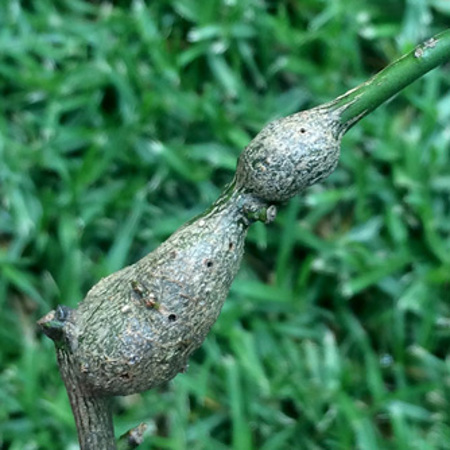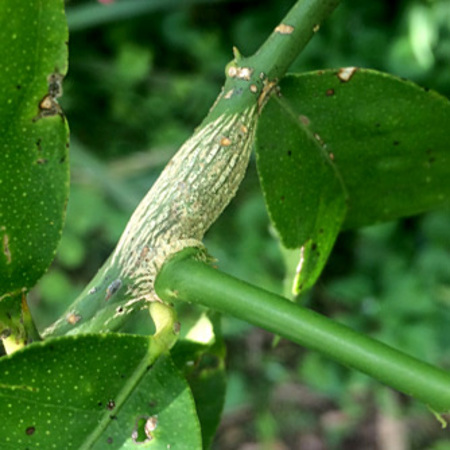Citrus Gall Wasp
BackCitrus gall wasps are very small wasps (2-3mm) which lay eggs in the bark of young stems in spring. When the larvae hatch they burrow deeper into the stem and feed on the citrus tissue. The tree reacts by producing extra cells in this area which ends up creating the distinctive galls. These galls protect the feeding larvae until they mature and emerge the following spring as adult wasps. There is only one generation per year.
In the beginning the galls are just slight swellings on the stems but as the months go by they enlarge and become very easy to spot. The gall also changes from green to a dull grey/brown colour. When the wasps emerge you can actually see small exit holes if you look closely.
Citrus gall wasps will only attack new growth and are particularly damaging on young trees as the galls can stunt their development. Severe and repeated infestation in established trees can reduce vigour, fruiting and cause dieback.
Plants Attacked by Citrus Gall Wasp
All citrus types are vulnerable including native finger limes.
Organic Control Methods for Citrus Gall Wasp
Adult wasps are short lived and die soon after laying their eggs in spring. Pruning off all galls, before the larvae can mature and emerge the following spring, is an effective way to control this pest.
Typically it’s advised to remove galls by August so there are none left in spring. However the galls will be clearly identifiable by late summer and if you cut them off then there’s still time for the tree to develop some replacement growth before it gets cold. So basically prune off the galls as soon as you are sure the odd swellings are actually galls. Throw the clippings in the bin or seal in a bag and leave to cook in the sun for a week or two before adding to the compost/shredder.
Citrus gall wasps don’t travel very far and usually only reinfest the tree they emerged from. This means if you are vigilant and prune off all galls quickly you can keep things under control. They can be blown about by the wind though and this can explain how they first arrived into your garden.
We do not recommend the sticky traps which are sold to catch the adult wasp. There is little evidence that they are effective and will just catch a whole range of beneficial insects.
Natural Predators of Citrus Gall Wasp
There are a couple of predators for the citrus gall wasp: Megastigmus trisulcus and Megastigmus brevivalvus. They’re types of wasps which will lay their eggs in the gall itself and their juveniles feed on the gall wasp juveniles inside the gall. Nasty business indeed
The citrus gall wasp is native to QLD and warmer parts of NSW but it has now spread much further. At this stage it’s unclear if their predator wasps have spread as far as they appear to be more cold sensitive. There is also increased concern that the use of systemic insecticides, in particular a group called neonicotinoids, is wiping out large numbers of beneficial predatory insects. For these reasons relying solely on the natural predators is rarely good enough and pruning the galls is still required.
Spray Options for Citrus Gall Wasp
Regular sprays of eco-oil during spring when the adult wasps are about could be helpful on two fronts:
- eco-oil is known to deter some insects from laying eggs (like citrus leafminer) and so it may also deter the citrus gall wasp.
- eco-oil contains special plant extracts which attract predatory insects that feed on common pests, including tiny wasps. It may attract the natural predators of the citrus gall wasp as well.
Note: These are just possible effects of eco-oil sprays. Trial work needs to be conducted to confirm if eco-oil will work in this way for this particular pest. At this stage pruning away galls is the only proven method to give control.





